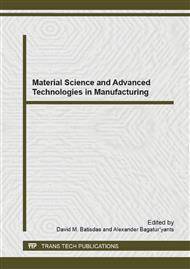[1]
D.W. Yerkes, S. Boonyakitsombut, R.E. Speece, Antagonism of sodium toxicity by the compatible solute betaine in anaerobic methanogenic systems, Water Science and Technology 36 (1997) 15-24.
DOI: 10.2166/wst.1997.0570
Google Scholar
[2]
Y.Q. Yang, D.G. Shen, N. Li, D. Xu, Y.Y. Long, X.Y. Lu, Co-digestion of kitchen waste and fruit-vegetable waste by two-phase anaerobic digestion, Environmental Science and Pollution Research 20 (2013) 2162-2171.
DOI: 10.1007/s11356-012-1414-y
Google Scholar
[3]
Z. Beno, J. Boran, L. Houdkova, T. Dlabaja, J. Sponar, Cofermentation of kitchen waste with sewage sludge, Pres'09: 12th International Conference on Process Integration, Modelling and Optimisation for Energy Saving and Pollution Reduction, Pts 1 and 2 18 (2009).
Google Scholar
[4]
M. o.H. a. u. -r. d. o. t.P. s.R. o. China, China's urban drainage and sewage treatment bulletin, Beijing, (2012).
Google Scholar
[5]
X. Liu, W. Wang, Y.C. Shi, L. Zheng, X.B. Gao, W. Qiao, Y.J. Zhou, Pilot-scale anaerobic co-digestion of municipal biomass waste and waste activated sludge in China: Effect of organic loading rate, Waste Management 32 (2012*) 2056-(2060).
DOI: 10.1016/j.wasman.2012.03.003
Google Scholar
[6]
H.W. Kim, H.S. Shin, S.K. Han, S.E. Oh, Response surface optimization of substrates for thermophilic anaerobic codigestion of sewage sludge and food waste, Journal of the Air & Waste Management Association 57 (2007) 309-318.
DOI: 10.1080/10473289.2007.10465334
Google Scholar
[7]
C.F. Liu, X.Z. Yuan, G.M. Zeng, W.W. Li, J. Li, Prediction of methane yield at optimum pH for anaerobic digestion of organic fraction of municipal solid waste, Bioresource Technology 99 (2008) 882-888.
DOI: 10.1016/j.biortech.2007.01.013
Google Scholar
[8]
M.A. Rahman, P. Elefsiniotis, The effect of upper mesophilic temperature and feed-to-seed ratio on batch anaerobic digestion systems, Journal of Environmental Science and Health Part a-Toxic/Hazardous Substances & Environmental Engineering 45 (2010).
DOI: 10.1080/10934529.2010.486346
Google Scholar
[9]
Y. Chen, J.J. Cheng, K.S. Creamer, Inhibition of anaerobic digestion process: A review, Bioresource Technology 99 (2008) 4044-4064.
DOI: 10.1016/j.biortech.2007.01.057
Google Scholar
[10]
P. Fongsatitkul, P. Elefsiniotis, D.G. Wareham, Two-phase anaerobic digestion of the organic fraction of municipal solid waste: estimation of methane production, Waste Management & Research 30 (2012) 720-726.
DOI: 10.1177/0734242x11429987
Google Scholar
[11]
B.G.M.E.D.R. Institute, (Ed. ), Water supply & Drainage Design Manual Volume V - Urban Drainage (Second Edition), China building industry press, Beijing, (2004).
Google Scholar
[12]
H.W. Kim, J.Y. Nam, H.S. Shin, A comparison study on the high-rate co-digestion of sewage sludge and food waste using a temperature-phased anaerobic sequencing batch reactor system, Bioresource Technology 102 (2011) 7272-7279.
DOI: 10.1016/j.biortech.2011.04.088
Google Scholar
[13]
S. Fu, X. Yan, Y. Fu, S. Yu, Mesophilic anaerobic digestion of sewage sludge and kitchen garbage, Journal of Harbin University of Commerce (Natural Sciences Edition) 23 (2007) 32-36.
Google Scholar
[14]
R.M. Dinsdale, G.C. Premier, F.R. Hawkes, D.L. Hawkes, Two-stage anaerobic co-digestion of waste activated sludge and fruit/vegetable waste using inclined tubular digesters, Bioresource Technology 72 (2000) 159-168.
DOI: 10.1016/s0960-8524(99)00105-4
Google Scholar
[15]
J. Yin, C. Zhao, L. Zhang, Start-up experiment of pilot-scale mesophilic two-phase anaerobic digestion of mixed sludge, China Environmental Science 28 (2008) 1100-1104.
Google Scholar
[16]
G.D. Zupancic, N. Uranjek-Zevart, M. Ros, Full-scale anaerobic co-digestion of organic waste and municipal sludge, Biomass & Bioenergy 32 (2008) 162-167.
DOI: 10.1016/j.biombioe.2007.07.006
Google Scholar
[17]
N.H. Heo, S.C. Park, H. Kang, Effects of mixture ratio and hydraulic retention time on single-stage anaerobic co-digestion of food waste and waste activated sludge, Journal of Environmental Science and Health Part a-Toxic/Hazardous Substances & Environmental Engineering 39 (2004).
DOI: 10.1081/ese-120037874
Google Scholar
[18]
L. Appels, J. Baeyens, J. Degreve, R. Dewil, Principles and potential of the anaerobic digestion of waste-activated sludge, Progress in Energy and Combustion Science 34 (2008) 755-781.
DOI: 10.1016/j.pecs.2008.06.002
Google Scholar
[19]
E. Athanasoulia, P. Melidis, A. Aivasidis, Anaerobic waste activated sludge co-digestion with olive mill wastewater, Water Science and Technology 65 (2012) 2251-2257.
DOI: 10.2166/wst.2012.139
Google Scholar


